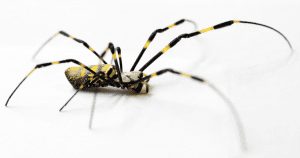
You asked, we answered. We’ve been getting questions about Joro spiders. Gail Reynolds from our UConn Extension Master Gardener program answered:
Joro spiders, Trichonephila clavata, have been sensationalized in recent news stories. The actual appearance of these spiders in Connecticut has not been documented. According to various reports, this spider was first noted in Georgia in 2014. Its arrival was most likely through imported shipping and/or plant materials. The Joro spider is native to China, Japan, Korea, Southeast Asia, and the eastern part of India.
The spider has not spread quickly and is found in northern Georgia, western South Carolina, and extreme southern North Carolina. They have been found in much lesser numbers in Tennessee and Alabama.
Most scientific assessments of this spider do not think the spider, or its eggs, can survive in colder temperatures of New England winters except perhaps for milder coastal areas.
The spider moves by spinning silk threads, which get caught by the wind and dispersed. The spider is only very mildly venomous and must be specifically provoked to bite.
Research has yet to determine if the Joro spider will displace any native spiders from their habitats or if they can all co-exist. University of Georgia scientists have reported that Joro spiders will capture and eat adult brown-marmorated stink bugs, another invasive insect and crop pest. Native spiders will not prey on the invasive stink bugs.
A good source for additional information: https://extension.psu.edu/joro-spiders